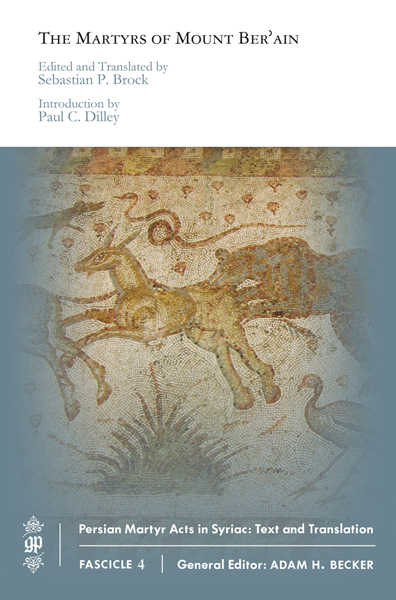Brock, Sebastian. 2014. The Martyrs of Mount Ber’ain (Persian Martyr Acts in Syriac: Text and Translation 4). Gorgias Press. With an introduction by Paul C. Dilley.
The Martyrs of Mount Ber’ain is the poignant tale of an Iranian nobleman’s three children, Adarparwa, Mihrnarse, and Mahdukht, who embrace Christianity after the youngest brother’s near-death vision of God. This decision estranges them from their disbelieving father and ultimately results in death at the hands of King Shapur II. Gabriel “the Cow,” abbot of the monastery of Beth ‘Abe, composed the account of these events in the middle of the seventh century.
The Martyrs of Mount Ber’ain provides important evidence for enduring concerns of Christian self-definition in the framework of the Sasanian Empire, especially as represented by the Zoroastrian priesthood. The three children, Adarparwa, Mihrnarse, and Mahdukht, work to forget their education by the Magi, with whom they soon find themselves engaged in battle; and yet some key features of the narrative, especially Mihrnarse’s vision, reflect shared idioms between Christians and their Zoroastrian rivals. This rivalry was committed to writing and commemorated even after the Arab conquest, and one of these three sibling-martyrs, the sister Sultana Mahdukht, is still memorialized in both Iraq and the United States.
Overview






 An important article by Heidemann, Riederer and Weber on a hoard of coins from the final years of the empire. I personally find the dipinti on the coins very interesting. Heidemann’s discussion of the hoard, his conclusions and Dieter Weber’s decipherment of the graffito are fascinating:
An important article by Heidemann, Riederer and Weber on a hoard of coins from the final years of the empire. I personally find the dipinti on the coins very interesting. Heidemann’s discussion of the hoard, his conclusions and Dieter Weber’s decipherment of the graffito are fascinating:
 Smith, Kyle. 2014.
Smith, Kyle. 2014.  McCollum, Adam Carter. 2013.
McCollum, Adam Carter. 2013.  Rapp, Stephen. 2014.
Rapp, Stephen. 2014.  Herman, Geoffrey. 2014.
Herman, Geoffrey. 2014.